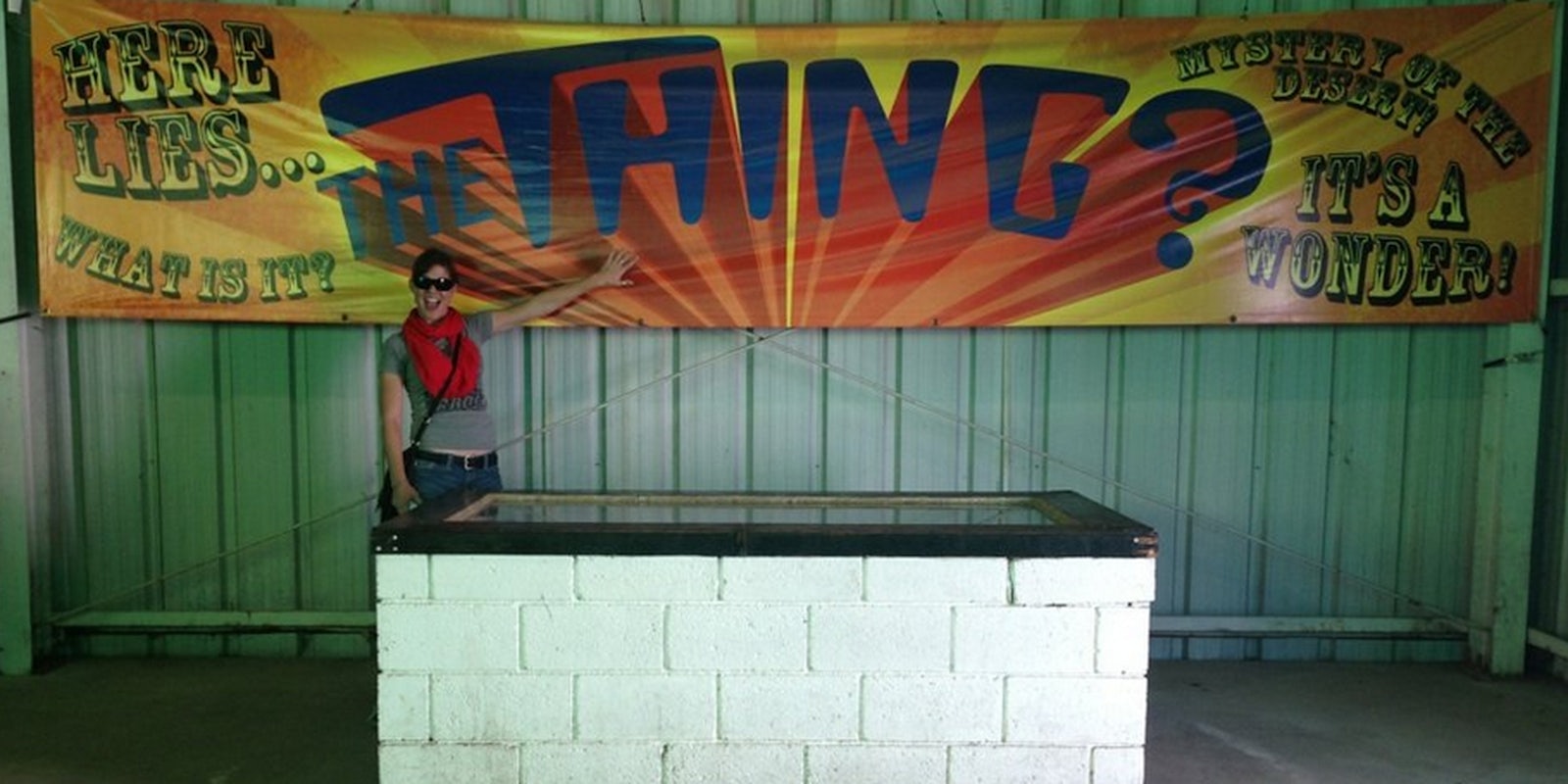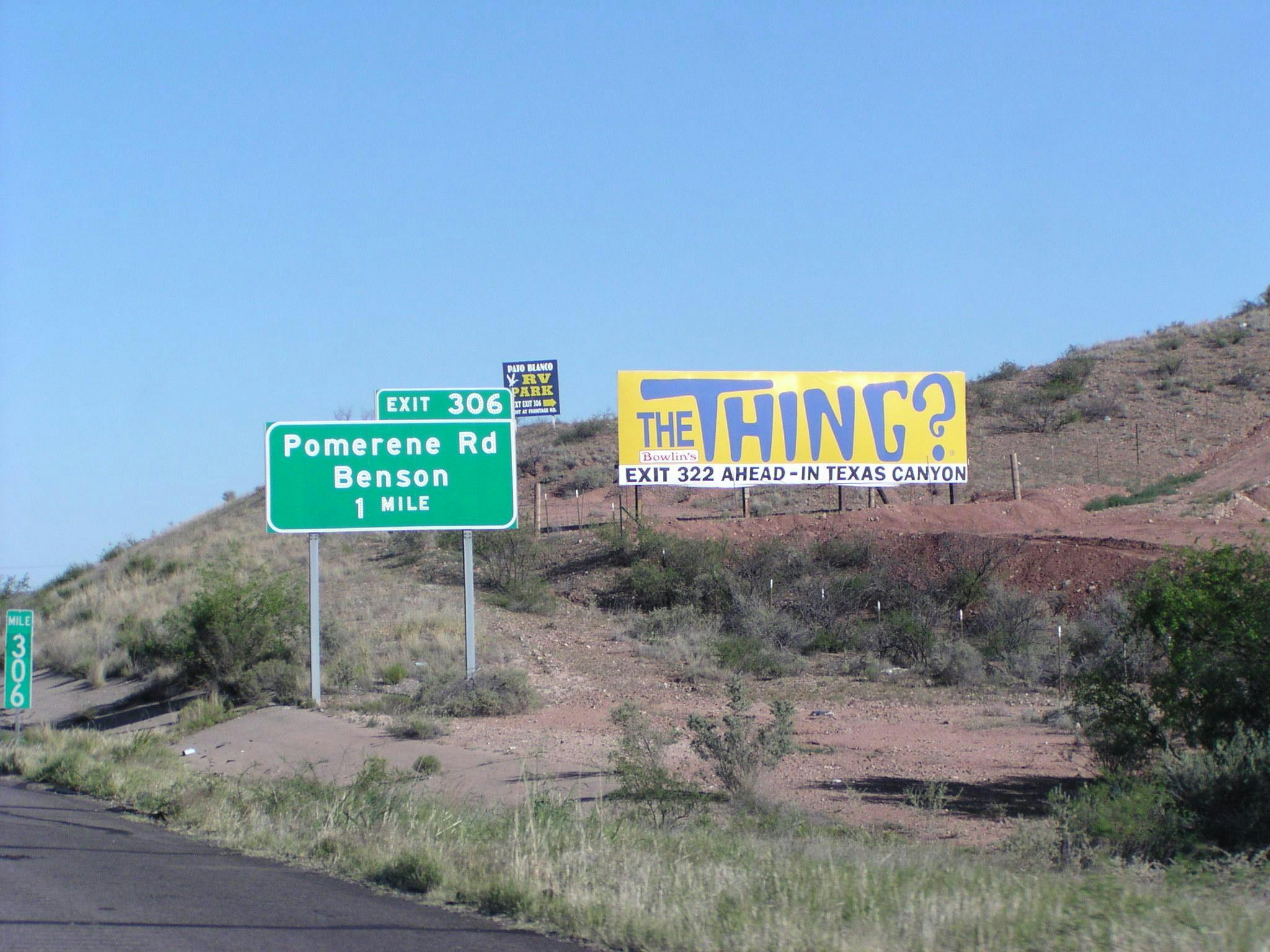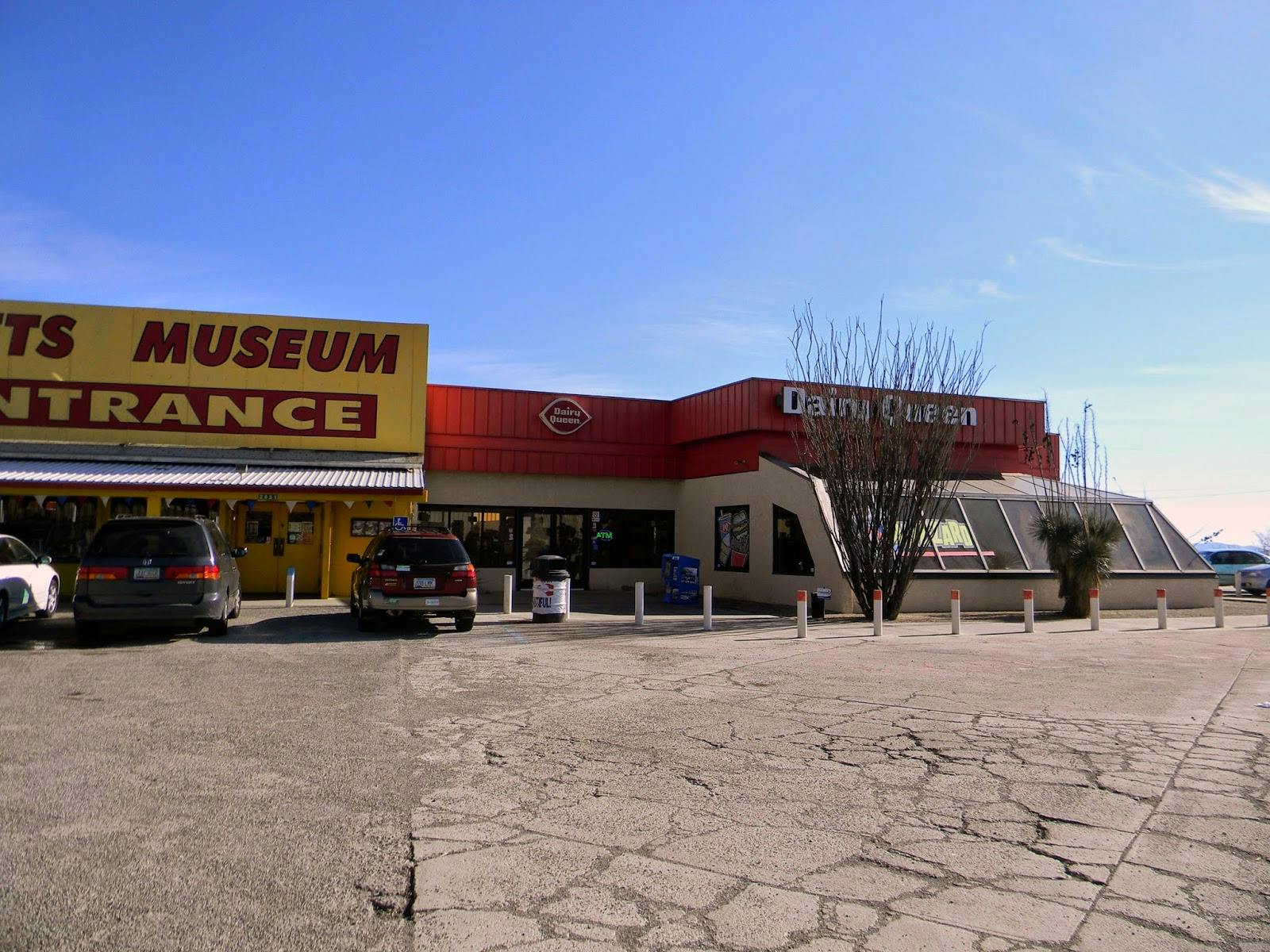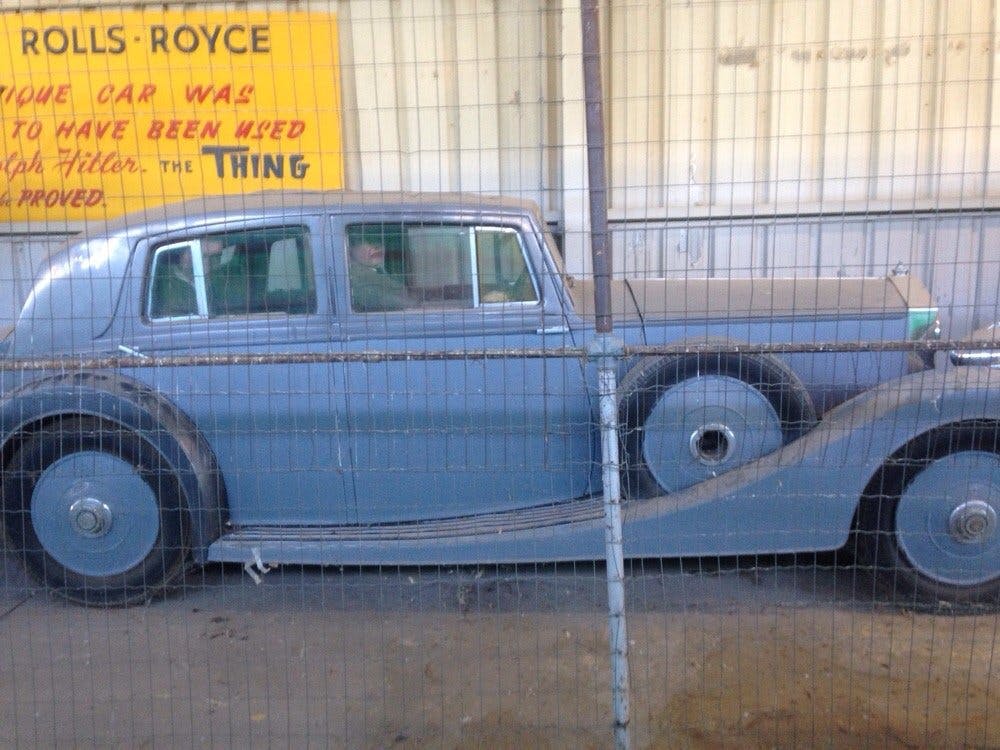“Mystery of the desert,” reads one billboard. “Seeing is believing,” explains another.
Driving on Interstate 10 between El Paso, Texas, and Phoenix you’ll spot these signs for a mysterious roadside attraction known as the Thing. They’re tough to miss: According to RoadsideAmerica.com, 247 of them were counted within a 200-mile span of highway. They’re also designed with the aesthetic of an early ’50s horror comic, which is a look that tends to stick out against the flat, brown terrain surrounding them.
The idea behind amassing the billboards is an obvious one—repetition is a good marketing strategy—but more than 50 years later they still work.
Their effectiveness makes perfect sense, though. After seeing a certain amount of billboards that are advertising something mysterious without clarifying details, bored drivers become prisoners of their own imagination.
It leaves the traveler’s brain muddled and unsatisfied as they obsess over the what. There’s only one thing that can restore their minds’ back to equilibrium—going to see about the Thing.
In fact, the whole operation—the billboards that continue to ominously appear on the horizon, and the museum of weird stuff that holds the key to restoring your piece of mind—is so airtight that it could only have one dangerous enemy. It must have been entirely unimaginable on the day that the first billboard was erected: A pocket-sized telephone that can provide the answer to what’s inside the Thing without having to visit it.
When the Thing attraction was first opened by Thomas Prince, along Highway 91 in the ’50s, things like mysteries, and the idea of having to see something to believe it, were still very solid concepts. They remained solid when the attraction was moved to I-10 a decade later, after an expansion of I-91 threatened to put the property in the middle of a highway if it didn’t relocate.
If smartphones had existed when the Thing first opened, it may have not been very successful. It’d be different if the attraction displayed highly regarded art, or authenticated historical artifacts. That was never its game. What it displayed was a (probably fake) mummy, and the existence of Google-ready phones would have spread that fact around very quickly.
Today most people can pick up their phones, and easily see the majority of the attractions inside of the Thing. This includes loads of photos of the Main Weird Thing that started the museum in the first place, and now concludes its tour.
“We’ve literally got billboards in hundreds of miles in both directions.”
But are smartphones crippling the attraction? Is the playful sense of mystery that kept I-10 travelers stopping by, and checking out those weird exhibits, becoming a casualty of the digital revolution? With the world’s knowledge at our fingertips, do the billboards still encourage people to stop at the attraction?
“We’ve not been hurt, in any way, by the digital revolution giving people information,” Bowlin Travel Centers, Inc., Director of Operations Kit Johnson told the Daily Dot. “If anything, it’s helped us.”
But why not? And why were we asking Bowlin Travel Centers, Inc., about the museum, anyway?
Both questions share the same answer: Bowlin had been partnered with the Thing, and the Prince family, for almost as long as the Thing has existed, and its side of the business not only keeps the attraction afloat today, but will do so for as long as it wants.
Bowlin began its operations more than 100 years ago in New Mexico—in the same year, 1912, that the territory became an official state—by trading with local Native Americans. It officially incorporated in 1953 after decades of expansion. It was this move that brought the company in touch with Thomas Prince, who’d purchased a creepy exhibit from a traveling roadshow (or from a catalog—the legend varies) which had become the keystone of a strange museum that he’d named the Thing.
When Bowlin partnered with the Prince family, it leased some neighboring land and built a small shop on it that sold a litany of souvenirs and highway supplies.
And that’s why the attraction is still running in 2015: As times have changed, the Thing has become an afterthought to those supplies, sold by Bowlin, that are accessible on a stretch of highway devoid of convenience stores and restaurants. In other words: The Thing doesn’t rely on revenue to survive, but is merely an extra incentive for travelers to stop at the Bowlin Travel Center’s gas pumps (instead of somebody else’s), or to get something to eat at the Dairy Queen on the lot (the result of a contract that Bowlin has held with the business for about 30 years).
So the Thing’s survival doesn’t have much to do with adapting to the digital revolution. In fact, it’s completely immune to it. It doesn’t cost much to run (Bowlin finally bought the land from the Prince family in 2010, which eliminated the leasing expenses), it’s fun to have around, and it adds something unique to what’s essentially a highly functional convenience store. Who would want to stop at a QT for gas, when you could get gas and also pay a dollar to go through the Thing’s extremely odd tour? The attraction is, essentially, a unique and historical advantage over Bowlin’s competition.
Oh, in case you were wondering, that wasn’t a typo: Admission to the Thing is one dollar.
“We charge $1 to go through the museum,” said Johnson, “and there’s some neat things in the museum, but they’re all kinda hokey, and none of them are validated.”
One of those things is a 1937 Rolls Royce, with a sign claiming that it once chauffeured Adolf Hitler around.
“What are the odds of that?” Johnson said about the Hitler car. “We kinda think it was, but we don’t have any validation on that.”
It’s exhibits like this in the museum that would kill it off within months if it were separated from its surrounding commerce.
“If I charged you $20 for it, you’d want your money back,” said Bowlin. “But if I charged you $1, you’d think it’s pretty cool.”
The other big reason that the Thing hasn’t been destroyed by the Internet: It’s ignored technology. What you ignore can’t hurt you, apparently. Johnson said that no efforts have been made to advertise the attraction digitally, and that lends it mystique.
When you compare it to basically anything else—say coffee mugs or energy drinks—and think about how amazing their websites are, your brain twists inside your skull when you realize that the Thing’s only online presence comes from bloggers, confused Yelp reviews, and one catch-all Wikipedia page.
Why fix an advertising technique that isn’t broken?
“For years and years and years, our most effective medium of advertising have been billboards,” said Johnson. “We’ve literally got billboards in hundreds of miles in both directions.”
And that brings us back to the billboards, and how they deeply embed taking exit 322 into your brain. Maybe you initially think “I’m not stupid—I’m not stopping for some idiotic tourist trap.” But then you pass it, and you look over—because you have to at least take a look at what’s been stuck in your head for hours—and see the reality of the situation: The location isn’t even that much about the Thing at all.
“It’s a little place where you can pull off the side of the road and get you an ice cream cone, get ya a sundae, getcha a burger, and sit down and eat,” said Johnson. And if you do get curious, while you’re eating that burger, you can “take a little tour, stretch your legs, and see the Thing for a buck… While you’re there, get some souvenirs for your family.”
Because the Thing is in Arizona, “souvenirs” include year-round fireworks. Johnson also said that parking is available for truckers, who they take great efforts to cater to. He also claims the restrooms are always clean, and in top-notch shape.
So the Thing might still be around because it is, at its core, a bait-and-switch routine to trick drivers into stopping at the location for gas, food, fireworks, and clean toilets. When you’re driving down a desolate stretch of highway, though, that’s a pretty good bait-and-switch to fall victim to.
Meanwhile the Thing itself, with its dollar admission and treasure trove of weird stuff, has experienced the exact opposite effect that we predicted. Instead of smartphones killing it off, it’s been indoctrinated by bloggers, and the lovers of strange things who follow them, as its own unofficial historic landmark.
And it isn’t going anywhere.
Screengrab via Monica S./Yelp





